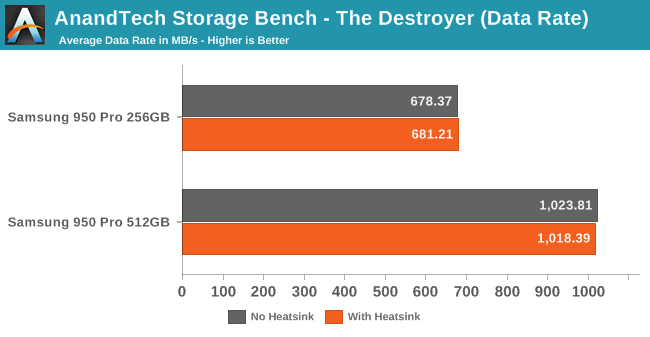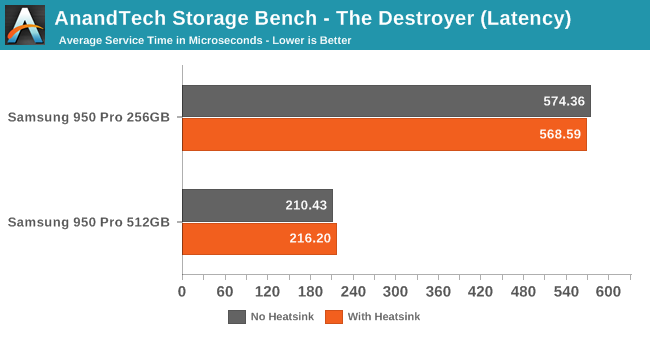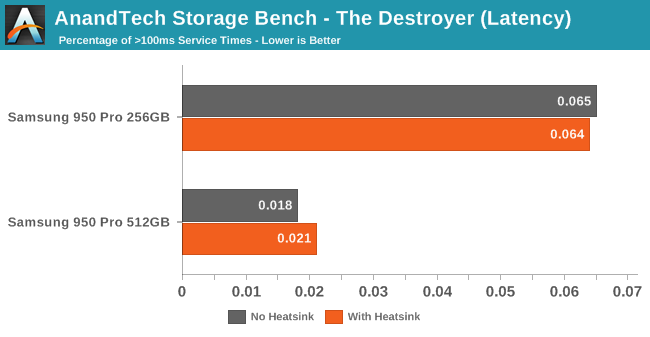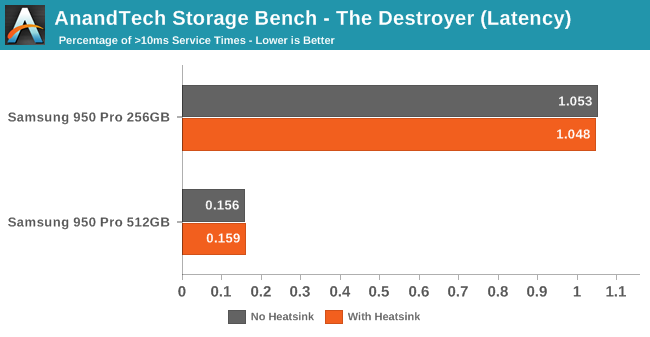The Angelbird Wings PX1 M.2 Adapter Review: Do M.2 SSDs Need Heatsinks?
by Billy Tallis on December 21, 2015 8:00 AM ESTAnandTech Storage Bench - The Destroyer
The Destroyer is an extremely long test replicating the access patterns of heavy desktop usage. A detailed breakdown can be found in this review. Like real-world usage and unlike our Iometer tests, the drives do get the occasional break that allows for some background garbage collection and flushing caches, but those idle times are limited to 25ms so that it doesn't take all week to run the test. Those pauses of up to 25ms are sufficient for the drive to complete a reasonable amount of background processing and return to idle, but they don't give the drive much time to cool off.


Average data rate on The Destroyer was essentially unchanged by the addition of the heatsink. The difference measured for average service time was slightly higher, but still insignificant. In both cases, the heatsink helped the 256GB drive and hurt the 512GB drive.


The frequency of latency outliers was also subject to some variation between runs, but its hard to attribute it to the influence of the heatsink since the effect was in the opposite direction for the two drives. With or without the heatsink the 950 Pro is posting great scores, and the 512GB drive outperforms the 256GB drive by a wide margin.










69 Comments
View All Comments
RealBeast - Monday, December 28, 2015 - link
"You know, since the LED's are white" Not really.Tell the Nobel committee about it. The 2014 prize in physics went to the blue boys -- red and green had been around for a while, and only they made white possible: http://www.nobelprize.org/nobel_prizes/physics/lau...
h4rm0ny - Tuesday, December 22, 2015 - link
Whilst agreeing with your point, you want either 'irrespective' or 'regardless', not "irregardless".More on topic I agree with both of you - I both recognize that what Teizo says about the customer base is probably true, and also agree with mooninite's despair that this is so. The two posts are not incompatible.
Murloc - Tuesday, December 22, 2015 - link
-less = withoutir- = in- before an 'r', the same as English un- (in- is latin, un- is germanic), it has a negative or privative force.
pick one but not both.
That said, RGB LEDs would make it cost too much, the price is already too high for consumers.
ddriver - Monday, December 21, 2015 - link
DO'H, it is not rocket science, if it overheads and throttles back as a result, then it obviously needs a heat sink.bug77 - Monday, December 21, 2015 - link
I think these tests answer another important question: when does it overheat.As it is, the drives only overheat during sustained write. This is far from unexpected, but at the same time it is reassuring to know it is the only scenario where a drive would throttle (as opposed to throttling under regular desktop usage).
ddriver - Monday, December 21, 2015 - link
But what about another important question, how much does it "hurt" to add a dollar worth of aluminum to improve a product worth several hundred dollars?bug77 - Monday, December 21, 2015 - link
If you have ever installed an M.2 drive, then you know there's not much space left for a heatsink. And you can only install it on one side. Even so, it's so close to the motherboard (and usually between PCIe slots) that if you don't have a hell of an airflow, it won't make much difference anyway.And that's only for desktops, good luck trying to fit a M.2 drive with a heatsink attached into an ultrabook.
ddriver - Monday, December 21, 2015 - link
You are very limited conceptually - it doesn't have to be a "radiator" type of heatsink, a flat piece of aluminum 2-3 mm thick would suffice. Heatsinks come in various shapes and sizes, not necessary the bulky, thick finned design.The SSD doesn't displace a lot of heat to begin with, but without a heatsink for that HEAT to SINK into the bare chip quickly runs out of thermal room.
Even if it still throttles, it will ramp the temp up slower as the heatsink will act as a buffer, and regardless of how little airflow it may have, a larger piece of aluminum will always displace much more heat than a tiny chip.
It will be slower to overheat and faster to cool, even in an ultrabook or tablet, and yes, with the kind of heatsink it merits it will have no trouble fitting into portable devices.
Judging by the performance regressions from adding a heatsink to the larger model, it would seem that engineers were well aware it throttles and have optimized the product for it, so taking care of the heat puts the device in a less than optimal standing. A firmware update should be enough to address this issue and eliminate any sort of performance regressions and actually improve it somewhat. Engineering a product which runs worse with better cooling - that's kind of an epic fail.
jjj - Monday, December 21, 2015 - link
Unless it detects benchmarks and lets the controller clock higher for better scores.If VW can do it , the possibility needs to be investigated elsewhere too.nathanddrews - Monday, December 21, 2015 - link
You know what this means, right? Next test: custom water blocks.